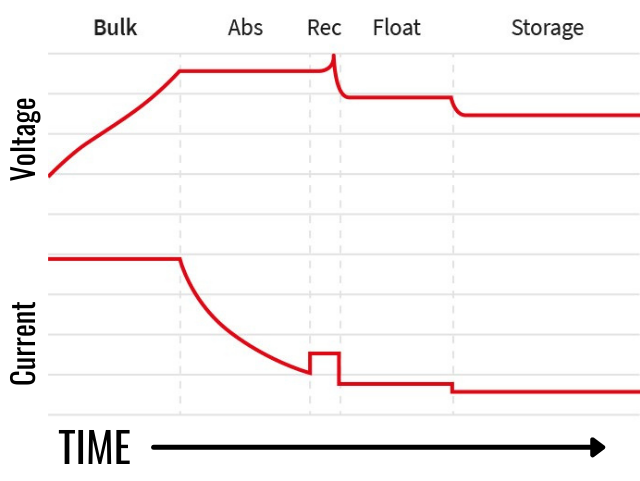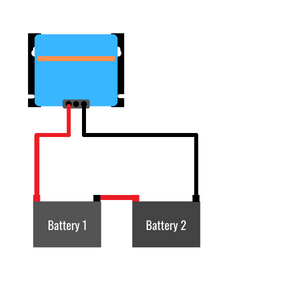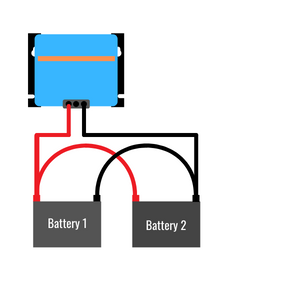| Mains Battery ChargingBattery chargers are essential to any 12V electrical setup, allowing you to replenish the charge that is drawn from your battery by your 12V circuits. Charging can be carried out using chargers that take their power from various different energy sources, e.g. vehicle or boat engine (known as a 'DC-DC charger'), from solar panels (known as a 'solar charge controller') or from a mains electricity supply (known as a 'mains charger'). Irrespective of the input source that the chargers use, they all work on a very similar principle to charge a DC battery, so in this guide we will be focusing on mains battery chargers as they are the most commonly used. Mains battery chargers work by converting a 240V AC power source into a DC output with a suitable charging profile for your battery type. Most modern battery chargers will have the option for you to select the type of battery being charged (and so make sure that the output is optimised for that battery type), however, some basic, less expensive models will only be suitable for certain types of battery. In this guide, we will walk you through the various things to keep in mind when choosing a charger. Multi-Stage Charging So, first let's understand how chargers work. Most modern chargers are multi-stage chargers which means that they go through various stages in their charging cycle where the current and voltage will vary in order to provide the best possible charge to the battery. This helps prevent over-charging, ensures that the battery is charged up to 100% and maintains the battery in an optimal state, all of which help maximise the life of the battery. Multi-stage chargers can be left permanently connected to the battery without causing damage, which means that whilst the battery is not being used the charger can prevent self-discharge (the process by which a battery slowly discharges over time, even with no loads connected). Older-style chargers that have a fixed voltage output can't achieve a full re-charge as they are unable to adjust the voltage level which would be needed to ensure full charge absorption. This type of charger cannot be left permanently connected as it will damage the battery. The table below gives a brief description of the various charging stages that modern chargers use. Not all chargers use all of these stages, but all will have Bulk, Absorption & Float as a minimum (known as 3-stage charging).
Charging Profiles Some battery chargers are able to alter the absorption and float charging voltage to best match a particular battery chemistry. This can be very important for sensitive battery chemistries likes calcium or lithium and will also help extend the life of AGM or GEL batteries. This can be an important feature then to look out for, especially if you think in the future you might change the battery chemistry you will be using. Each battery will come with its own characteristics and whilst most batteries in the same chemistry family will share the same charging voltage, it is worth knowing what is best for your battery by checking the datasheet provided by the manufacturer or retailer. These types of charger will typically have a way of selecting the battery chemistry when you set up the charger (via either software or switch settings on the charger itself) and some may even allow you to manually set the charging voltages, which can be useful if the pre-programmed voltage settings don't quite match those recommended by the battery manufacturer. In the table below we have listed the common charging voltages for each battery chemistry, however, this can differ depending on the manufacturer of the battery so it is important to check.
Which size do I need? Picking the size of the charger is critical to making sure your battery will not be damaged & will perform at its maximum capacity. If you select a charger that delivers a higher charge current than your batteries can handle you can damage the battery, reducing its capacity and life span. Conversely, if you select a charger that has too low a charge current you can also cause lead-sulphate crystals to build upon the lead plates, which can reduce the battery's charge-holding capability. For wet lead-acid, AGM & GEL batteries, it is a general rule of thumb to rate the charger to deliver 10-20% of your battery's rated capacity (i.e. for a 100Ah battery, a 10-20A charger would be best suited). Lithium batteries can handle much higher charge currents and can therefore have reduced recharge times. You will find the charging current limit for a lithium battery on the manufacturer's datasheet. Charging multiple batteries Some chargers may have multiple outputs meaning the charge can be shared across batteries or battery banks. This can be extremely helpful if you have multiple batteries that you want to charge from a single charger. Most of these chargers, however, cannot be used on mixed chemistries, meaning all your batteries would need to be in the same chemistry family and the charge current would be split between the outputs. The amount of charge delivered by each output would depend on the initial state of charge of each of the connected batteries (batteries with a lower state of charge, and therefore a lower resistance, would receive a higher current during the bulk stage). If, however, your batteries are connected in parallel or series, you will only need a charger with one output. This is because, when connected in either of these configurations, the batteries are operating as one larger battery. You would only need to make sure your charger is rated for the change in voltage or capacity (Ah) as a result of connecting them together.
Example 1: 2x 12V 100Ah Batteries in series = 1 x 24V 100Ah, requiring a 24V charger rated for 10-20A
Example 2: 2x 12V 100Ah Batteries in parallel = 1 x 12V 200Ah, requiring a 12V charger rated for 20-40A We hope you have found this guide helpful and to see our full range of mains chargers please visit here Disclaimer - The information contained in these articles is provided in good faith and we do our best to ensure that it is accurate and up to date, however, we cannot be held responsible for any damage or loss arising from the use or mis-use of this information or from any errors or omissions. The installer is ultimately responsible for the safety of the system so if you are in any doubt, please consult a qualified electrician. |
12 Volt PlanetAuto & Marine Electrical Components |











